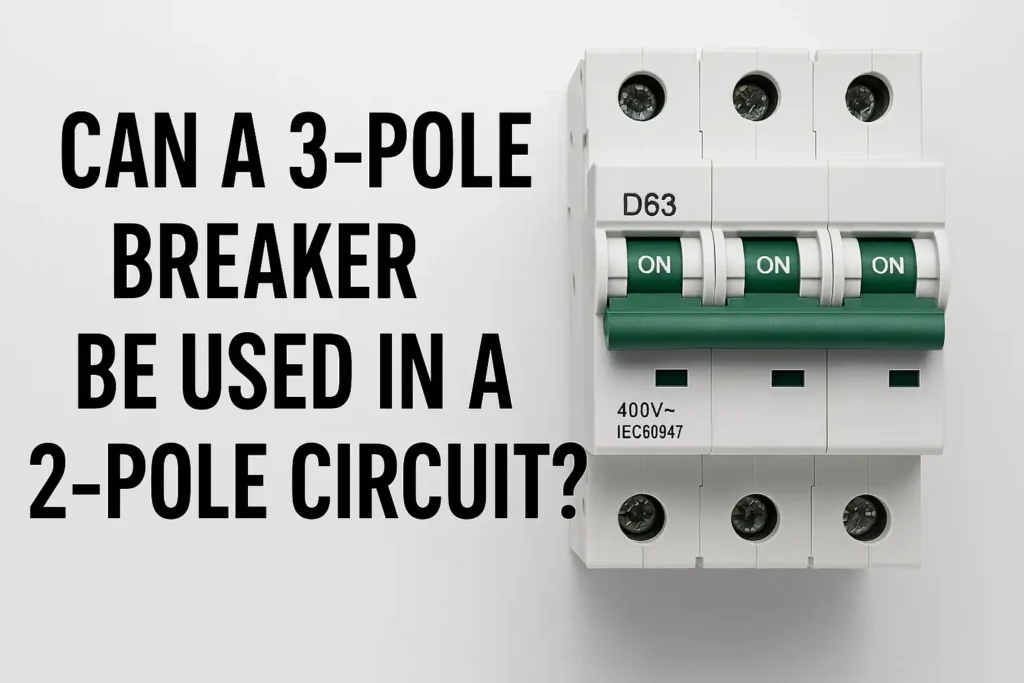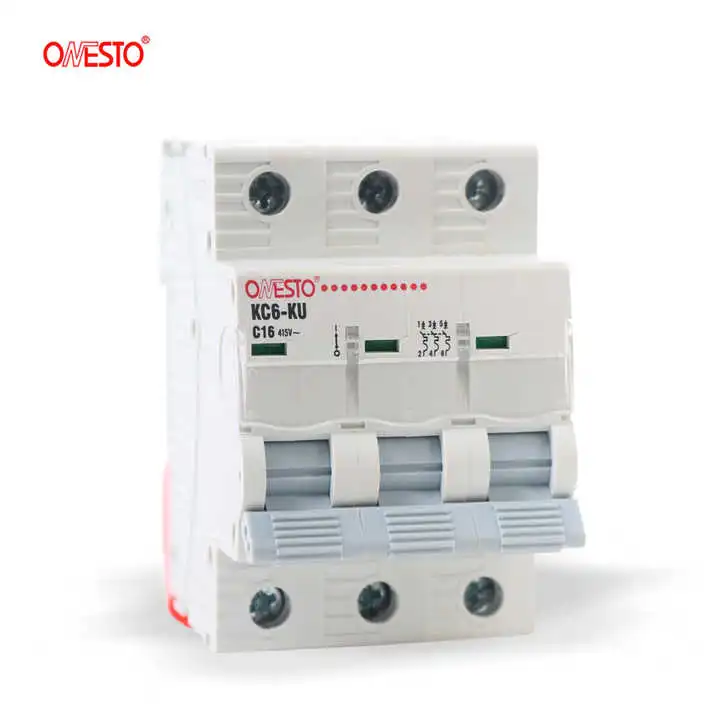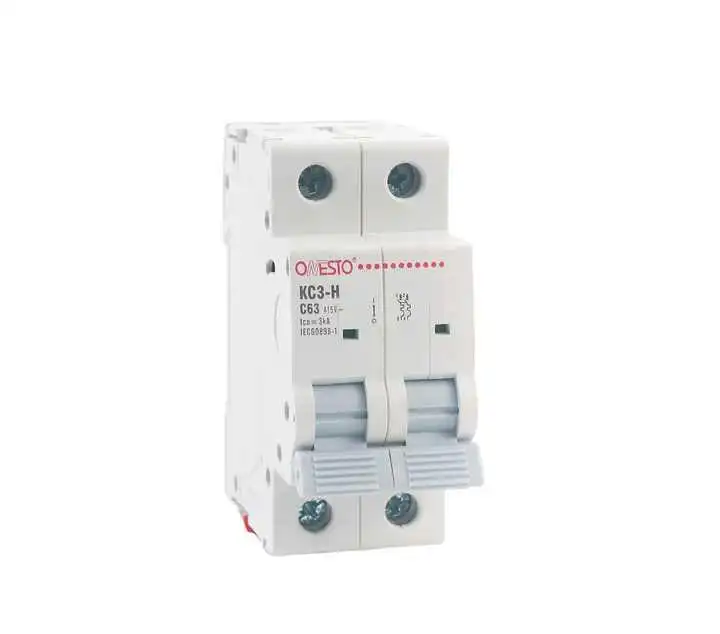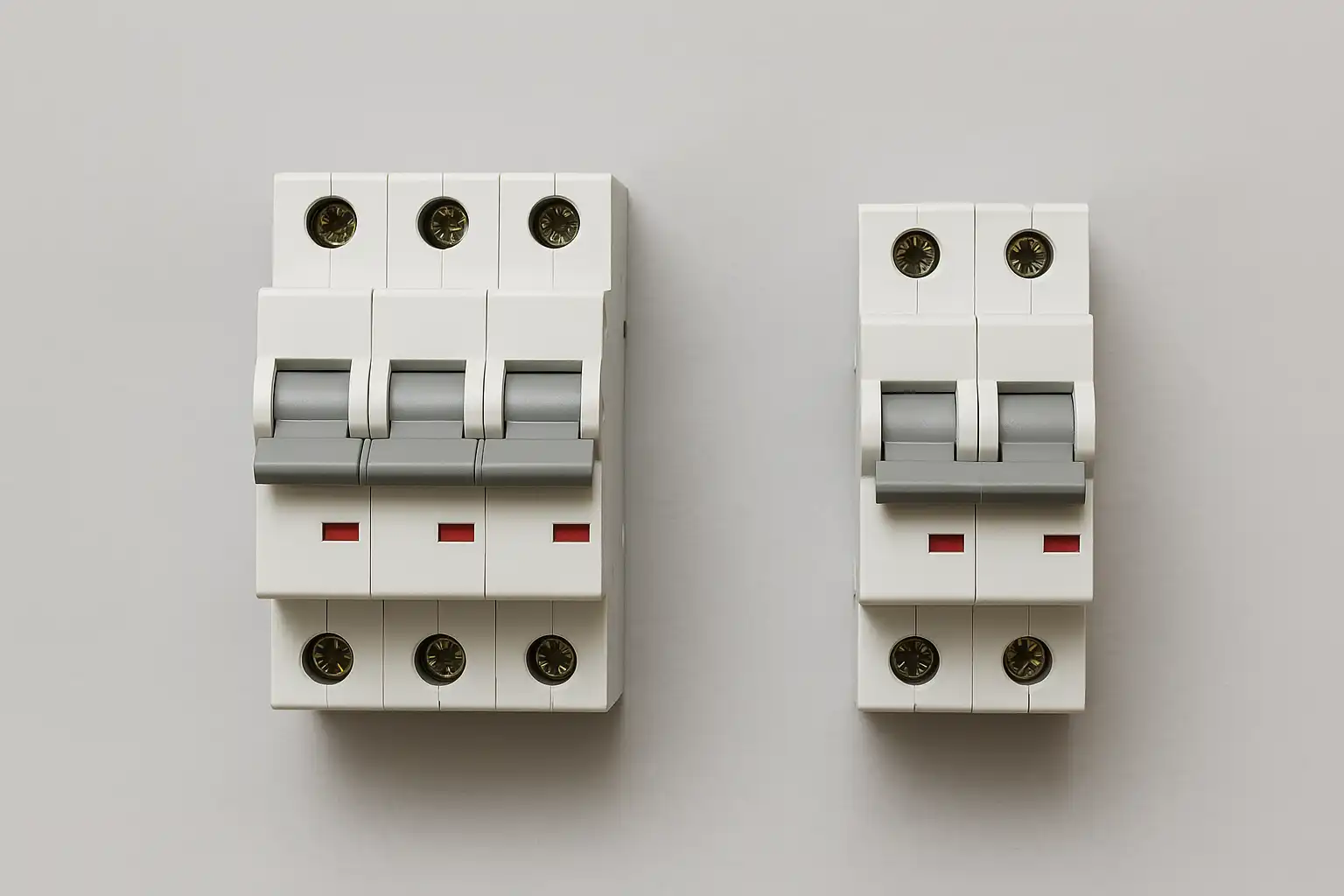Key points
In the absence of a two pole circuit breaker, a three pole circuit breaker can be used as a temporary alternative, but the following conditions must be met:
- Only use two-phase contacts, keep the third pole in an open state;
- Ensure that the neutral wire is connected through independent terminal blocks to avoid misconnection
Below, I will focus on explaining the knowledge of replacing a 2-pole circuit breaker with a 3-pole circuit breaker
What is a three pole circuit breaker?
Three pole circuit breaker is a three-phase power system protective device, designed for disconnecting, regulating and protecting power lines. Its “3 poles” indicate L1 L2、L3,There are three independently connected poles, each provided with a thermal magnetic protection unit. Three pole circuit breaker is capable of disconnecting three-phase currents simultaneously to make synchronous power-off of the system in fault occurrence to prevent equipment damage or fire accidents.
Structural characteristics
- Contact system: Three independent sets of contacts are used to conduct or disconnect current;
- Release device: including thermal release (overload protection) and magnetic release (short circuit protection);
- Operating mechanism: manual or electric switch device;
- Arc extinguishing device: used to safely eliminate arcs during power outages.
What is a 2-pole circuit breaker
A 2-pole circuit breaker is a bipolar electrical protection device that can simultaneously control the on/off of the live wire (L) and neutral wire (N), and cut off the power supply in the event of overload, short circuit, or leakage in the circuit. Two pole circuit breakers are widely used in electrical protection systems of civil buildings, offices, and small shops.
Comparative analysis of 2-pole circuit breaker and 3-pole circuit breaker
| Parameter | Two-Pole Circuit | Three-Pole Circuit |
|---|---|---|
| Voltage | 220V | 380V |
| Number of Wires | Two wires (L + N) | Three wires (L1, L2, L3) |
| Suitable Areas | Residential, Light Load | Industrial, Heavy Load |
| Corresponding Breaker | 2P | 3P or 3P+N |
Feasibility analysis of using a three pole circuit breaker for a two pole circuit
From an electrical safety perspective, as long as the wiring is correct and insulation and labeling are done properly, it is feasible to use a three pole circuit breaker for a two pole circuit. However, it should still be noted that:
- A three pole circuit breaker can use only two contacts (such as L1 and L2) to leave the third pole idle. At this point, its function is similar to a two pole circuit breaker, but it is necessary to ensure that the neutral wire is correctly connected to the protective ground wire
- The rated current and breaking capacity of a three pole circuit breaker need to be matched with a single-phase circuit. For example, if the rated current of a three pole circuit breaker is 32A and the load of a single-phase circuit is 20A, it is technically feasible
Actual wiring diagram and explanation
| Phase | Terminal Connection | Suggested Operation |
|---|---|---|
| L1 | Connect to phase wire | Normal use |
| L2 | Connect to neutral wire | Normal use |
| L3 | Empty | Do not connect, only for sealing or backup use |
The use of a three pole circuit breaker in a single-phase 220V system generally follows the following connection method:
- L1 is connected to the phase line;
- L2 is connected to the neutral line;
- The L3 port is sealed with an insulating cover and no connection is made;
- Ensure that the three pole linkage is tripped.
Why would someone consider using a three pole circuit breaker instead of a two pole circuit breaker?
- Convenience of procurement
In some engineering projects, imbalanced inventory resources or supply shortages may result in a lack of sufficient suitable two pole circuit breakers to choose from. At this point, using a three pole circuit breaker as an alternative solution can save time and costs, especially during emergency repairs or temporary wiring. - Cost considerations
Maintenance devices are usually equipped with 3P circuit breakers instead of purchasing 2P devices to avoid additional inventory management costs. In some cases, it is economically more feasible to replace 2P circuit breakers with 3P circuit breakers based on the principle of functional compatibility.
What are the hazards of replacing a 2-pole circuit breaker with a 3-pole circuit breaker
The 3-pole circuit breaker is designed specifically for three-phase circuits, and replacing the 2-pole circuit breaker may not fully protect single-phase circuits and may lead to the following dangerous behaviors.
- Leakage risk: 3P circuit breakers usually do not detect single-phase leakage current, which may lead to electric shock hazards.
- Live neutral wire: If the neutral wire is not disconnected, it may become live during a fault, posing a threat to personal safety.
- Insufficient overload protection: Single phase loads may cause mismatched thermal magnetic trip parameters of 3P circuit breakers, delay or fail to cut off fault currents.
Conclusion
From the above discussion, three pole circuit breaker can be used for two pole circuit but with the condition: proper connection, proper safety isolation, and specified purpose and cycle. However, choosing a circuit breaker with matching poles is still the best choice. For temporary use, emergency, or inventory control, replacing two poles with three poles is an understandable but cautious option.
FAQ
Is it safe to leave one pole empty in a three pole circuit breaker?
Yes, if properly insulated and labeled, the empty pole will not be powered on and is basically safe.
Will using a three pole circuit breaker affect circuit performance?
Generally speaking, it is not possible, but uneven current distribution can cause certain components to age faster.
Is it possible to wire household distribution boxes in this way?
Not advisable. It is recommended to directly apply the 2P model to household applications, which facilitates maintenance and repair.
Read the following article for more information:
Single pole miniature circuit breaker
What Are the Key Differences Between 3-Pole and 4-Pole Circuit Breakers






